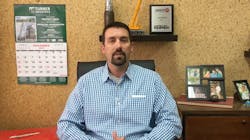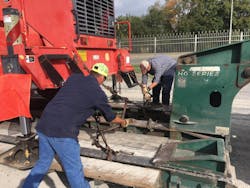Hard Work Rules for Jesse Morain
Jesse Morain, 37, had to make his own way. His father, who himself had spent 43 years working his way up from apprentice to an executive VP at Turner Industries, a Louisiana-based crane, rigging, and specialized transportation firm, made sure of it.
When the younger Morain started at Turner, everyone in the business—no matter who they were—had to start from entry level with the hard work and what some would refer to as the dirty jobs.
Those were the rules in the business and at Turner, a family-owned company that has seen a number of father-son combinations help build its workforce.
“I had to start as an ‘oiler’ [apprentice],” Morain says. “I was given the nastier jobs, the go-out-of-town jobs, more often then most, just so that my dad could make sure no one could say I got an extra leg up because of who I was.
“Out in the field, I was building the cranes, but then I wouldn’t be able to sit on the job and make the ‘easy money,’ as they say,” Morain says. “I’d move on to another job site and someone would take my place and make the easy money while I’d go out and build the next crane.”
The constant travel and crane building wasn’t even the most challenging part of it.
Morain’s rather claustrophobic steam baths were 18 years ago. Today, he’s the branch manager for the hub of the company’s equipment division. Morain is in charge of operations, scheduling, maintenance, following Federal guidelines, inspections, the billing and administrative sides, hiring, and coordinating with other branches to make sure they have the equipment and staff they need. It’s a ton, but at least he can do much of it in air conditioning.
“It’s somewhat surreal, looking back at it,” he says of his rise through the ranks. “I’m a third-generation employee for this company, so I’ve been given opportunity, but I’ve had to work for it. Just like everyone on our team, every opportunity that presented itself, I was able to take it and do the best I could. I like to think I’m a driven person; I don’t like to just settle. I want to keep growing. As soon as I do anything, I want to be the best at it.”
Turner is an industrial services company with maintenance divisions, turnaround divisions, construction divisions, and “almost every facet of industrial construction or maintenance,” Morain says.
It has one of the larger rough-terrain fleets in the Gulf South. “We own 300 or so RT cranes. We also have partners that we work with where we lease and sublet to get additional equipment when our fleet’s not big enough,” Morain says.
Turner’s fleet includes the RT cranes in its possession, 53 crawler-boom, hydraulic-boom, and lattice-boom models with lifting capacity through 800 tons, a few pieces of earthmoving iron for special projects, a 500-ton gantry system, a number of 120-foot extended trailers with hydraulic leveling, and an assortment of chokers, shackles, beams, and pieces for specialized rigging. The division manages 2,500 vehicles, as well. It all adds up to an ERV of between $200 and $250 million.
Want to know more about the Under 40 in Construction Equipment Awards? Watch the video below.
Morain tracks it all with a balanced mixture of old and new technology, but no OEM telematics, as of yet. “Most of it is pen and paper, as far as tracking the rigging and the equipment, and we have a software system that we use to track the maintenance and scheduling of all of our equipment,” he says. “The cranes are all kept on that. As far as the service and maintenance, we keep all the hours, the guys turn the hours in daily or weekly, and we maintain a schedule in the system that will tell you when it’s time to see if a piece needs to be serviced.”
Once Morain became branch manager, he helped design and implement the software system, Equipment Life Cycle, by Dysel. Turner uses a third-party provider, NexTraq, for GPS and monitoring driver behavior and speed on 30 to 40 percent of its on-highway vehicles, such as pickups.
“Before I started this position, we did everything with pen and paper,” Morain says. “We had no scheduling software, no tracking software. We did everything in a notebook or Excel spreadsheet. We haven’t pushed into it [telematics] very deeply. Our fleet is still small enough to monitor the way that we do.”
The maintenance and scheduling software was a bit of a sea change for some Turner employees. “Many of the people here are 30-, 40-, even 50-year veterans,” Morain says. “So they were used to pen and paper, and file cabinets, and that’s just the way everything’s been done for years. To this point, it’s been pretty successful.” Morain says that he’s had some of those long-time employees approach him just to tell him they’ve seen the system’s benefits.
Turner does the majority of its maintenance, and marches to its own beat on PM timing.
“We have our maintenance schedule set up on 250 hours,” Morain says. “Most manufacturers recommendations are at 500 for your standard oil change. We keep our schedule at 250, that way we have a little bit of wiggle room if we don’t hit it right away, if it’s on a job or something.” The net result is that maintenance is often done ahead of schedule.
Morain also keeps the repair-or-replace decision pretty simple. “Because we’re maintaining and operating our machines, we don’t replace them quite as often as most people,” he says. “Most of it is determined on the revenue produced by that particular machine versus the cost. If the machine is still profitable at the end of the year, we continue to utilize it. [This goes on] until we find that it just costs too much to maintain a good profit.”
Most of Turner’s equipment is bought and paid for before it hits a job, Morain says, and the company doesn’t lease very often. Without a set replacement schedule on pieces, some machines in the division are pushing 30 years old. “We keep them until they’re not safe or economically worth it anymore,” Morain says.
Turner and Morain have seen a 108-percent increase in revenue over the last seven years, so the system works. “I can’t take all the credit for that,” he says. “We don’t say ‘no’ to work. One of the things that we’re known for is that we move things around and make stuff happen. So if a customer calls and needs a machine or has a project, we won’t say, ‘No, we’re not available.’ We’ll figure it out. We’ll get with our other groups, whoever we have to get with, to make something happen.”
Morain says several factors came together at the same time to give Turner a boost. “It started post-Hurricanes Rita and Katrina, when the industry had a lot of work to do and then there were some EPA regulations that the facilities had to meet by a certain deadline. So there was a lot of money in from fracking that a lot of facilities used for those capital projects. We were able to parlay all that into an increase in business,” he says. “At the same time, the growth in business allowed us to buy additional equipment for the new work. The industry was really in our favor and we were able to pull together and take advantage of it.”
All the while, Morain kept his head down and followed his father’s example of the hard work expected to climb the ladder. The younger Morain is proud to work with his dad, and he still feels pressure to prove himself.
“I have a pretty good work ethic,” Morain says, “and my dad is not one of these ‘let-me-help-my-son’ bosses—he made sure everybody knew I didn’t get any favoritism when I started here. I feel like the way I got to this job was through hard work.”
Neither Morain, nor Jesse’s grandfather, would have it any other way.

